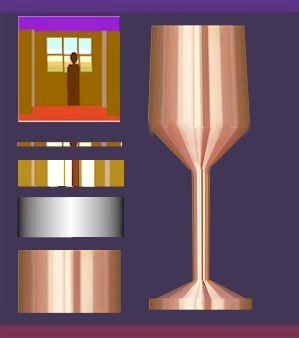2-2 SILVER AND COPPER

|
SILVER
Technical:
Second to gold as most malleable. Oxides are black forming silver sulphide (try egg yolks) - see dark cracks in example. Spitting silver, when silver cools it expels oxygen and spits. Used as an alloy, in photography and for coins. Absorbs most hues equally but seems to reflect minor amounts of most.
Conceptionally :
Precious metal with dull lustre. Jewellery, tableware. Combines well with gold and glass and useful for subtle neutral highlights.
Presentation:
Always try and understate - against a dark background if possible. As with the pearl, silver can be painted over with a milky rainbow-hued semi-transparent film. Adaptable for use beside objects with strong hues as it will give nice secondary glows. Make colors as subtle as possible.
|
Painting:
First paint in grey as slick and smooth as possible making sure to roughly place the highlights. Allow to dry then glaze with thin quick drying medium. When dry scrumble on red blue and yellows in minute milky amounts. When dry glaze again ( or else you can apply the colors thinly within a medium). Scrumble on colors reflected from nearby objects etc. Place some opaque highlights and merge with surrounding areas until a dull glow is achieved.

|
COPPER
Technical:
Found in pure state and can be beaten into shape when cold. Alloyed with tin gives bronze. Used as plates for engraving and etching. Oxidises a green-blue. Often mined with sulphur which is burnt off in smelting. Great conductor - wide use as cooking utensils. Copper is usually fashioned using a 'ball-pane' hammer which has a rounded face. This gives it that distinctive ripple effect.
Conceptional:
Coins, warm brown colors with irregular highlights. Goes in and out of fashion with house utensils etc. Age-old metal easily beaten into relief panels which some years ago were made into stand-alone decorations.
Presentation:
Best given the beaten effect - see below. Hints of green in the shadows with subdued red-yellow hues in middle tones.
|

|
Painting:
First use a semi-neutral background color such as raw umber to create forms and shading. Add a little cobalt blue to deepen the forms if necessary. Glaze. Apply mid-tones (I used a thin burnt sienna) feather the edges for a ripple effect but do not blend as with silver. Paint highlights wet in wet keeping edges round but sharp. Glaze when dry.
STUDENT ACTIVITY:For this page and the previous - find your own cylindrical object (cup) and paint it as chrome, gold, silver and copper. Allow 80min.
GO TO ... photo-realism
... or lesson list
|
|


